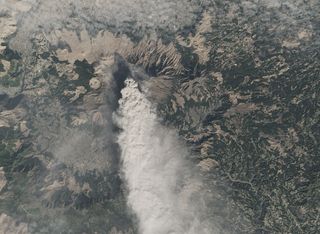Retracted Study: How a Volcano in Japan Halted an Earthquake

Editor's note: The paper related to this research was originally reported by Live Science on Oct. 20, 2016, but was retracted by the journal Science on May 3. A recent investigation into the study uncovered manipulated images and falsified data, Science announced in a retraction statement. The article below remains as originally published, but the study's findings should no longer be considered valid.
Original article below.
Mount Aso, one of the most active volcanoes in Japan, recently helped to stop a powerful earthquake before it subsided on its own, researchers discovered.
When a 7.1-magnitude quake struck Kumamoto, Japan, on April 16, 2016, it opened surface ruptures in a zone extending 25 miles (40 kilometers) in length. But scientists found evidence suggesting that the powerful earthquake was halted by a magma chamber under the Aso volcanic cluster, located 19 miles (30 km) from where the quake originated.
This finding provided scientists with a rare glimpse of how two geological phenomena — volcanoes and earthquakes — may interact. This topic is of particular interest in Japan, which is particularly vulnerable to both volcanoes and earthquakes. [The 11 Biggest Volcanic Eruptions in History (Photos)]
An earthquake is a sudden release of pent-up energy in Earth's crust that has accumulated over time, generated by shifting tectonic plates. When two sides of a fault, or crack along a plate boundary, move apart or slide suddenly past each other, energy gets released. The waves of energy radiate outward from that jolt, often producing shaking on Earth's surface, according to the U.S. Geological Survey (USGS).
Japan is especially prone to earthquakes, as it lies in the Pacific Ring of Fire, a U-shaped area in the Pacific Ocean where several tectonic plates meet, and where many earthquakes are generated.
Sign up for the Live Science daily newsletter now
Get the world’s most fascinating discoveries delivered straight to your inbox.
A number of volcanoes are also found in this Ring of Fire. And it was the particular interaction of the April 2016 earthquake with the Mount Aso volcano that triggered the researchers' interest in how seismic activity could be affected by the structure of volcanic clusters.
Shortly after the Kumamoto quake, the researchers visited the epicenter — the place on Earth's surface directly above where the earthquake originated — and spent 10 days investigating the ruptures left behind by the quake.
They discovered fresh ruptures that extended into Aso's caldera — a large, bowl-shaped depression at the volcano's summit — from the southwest to the northeast edge. And they abruptly ended there, at depths of 3.7 miles (6 km) below the surface.
Investigations of seismic activity deep under the caldera where the ruptures stopped indicated that there was a chamber holding magma — the same hot, fluid material called lava when it reaches Earth's surface — at that very spot,
Energy waves from the quake traveled toward Mount Aso through cool, brittle rock, the study authors wrote. But the sudden encounter with the extreme heat generated by rising magma under the volcano dispersed the energy upward and outward, sapping the strength of the quake's flow and stopping the rupture, they explained.
"This is the first case concerning the interaction between the volcano and co-seismic rupturing as we know so far," study lead author Aiming Lin told Live Science in an email.
Lin, a professor in the Department of Earth and Planetary Sciences at the Faculty and Graduate School of Science at Kyoto University in Japan, said that although this is the first reported evidence of a volcano putting a stop to an earthquake, there are other historical examples that could represent similar activity.
In 1707, ruptures generated by the Houei-Tokai-Nankai earthquake (magnitude 8.7) extended northward and eventually terminated at the western side of Mount Fuji, Lin wrote. And in 1930, the rupturing of the magnitude-7.3 North Izu earthquake was interrupted at the Hakone volcano in Izu Peninsula.
"Along this line, we are studying the interaction between the active faults — including co-seismic rupturing — and large earthquakes in Japan," Lin said.
This discovery could help researchers more accurately anticipate earthquakes' duration relative to their interaction with volcanoes, according to seismologist Gregory Beroza, deputy director of the Southern California Earthquake Center and a professor of geophysics at Stanford University.
"What it might mean for earthquakes is that magmatic systems might segment faults and, by doing so, limit the size of earthquakes in a predictable way," Beroza, who was not involved in the study, told Live Science in an email.
"This is just one earthquake, however," Beroza added. "No matter how interesting it is, or compelling it looks, it's potentially hazardous to generalize to future earthquakes."
The findings were published online today (Oct. 20) in the journal Science.
Original article on Live Science.

Mindy Weisberger is an editor at Scholastic and a former Live Science channel editor and senior writer. She has reported on general science, covering climate change, paleontology, biology, and space. Mindy studied film at Columbia University; prior to Live Science she produced, wrote and directed media for the American Museum of Natural History in New York City. Her videos about dinosaurs, astrophysics, biodiversity and evolution appear in museums and science centers worldwide, earning awards such as the CINE Golden Eagle and the Communicator Award of Excellence. Her writing has also appeared in Scientific American, The Washington Post and How It Works Magazine.

